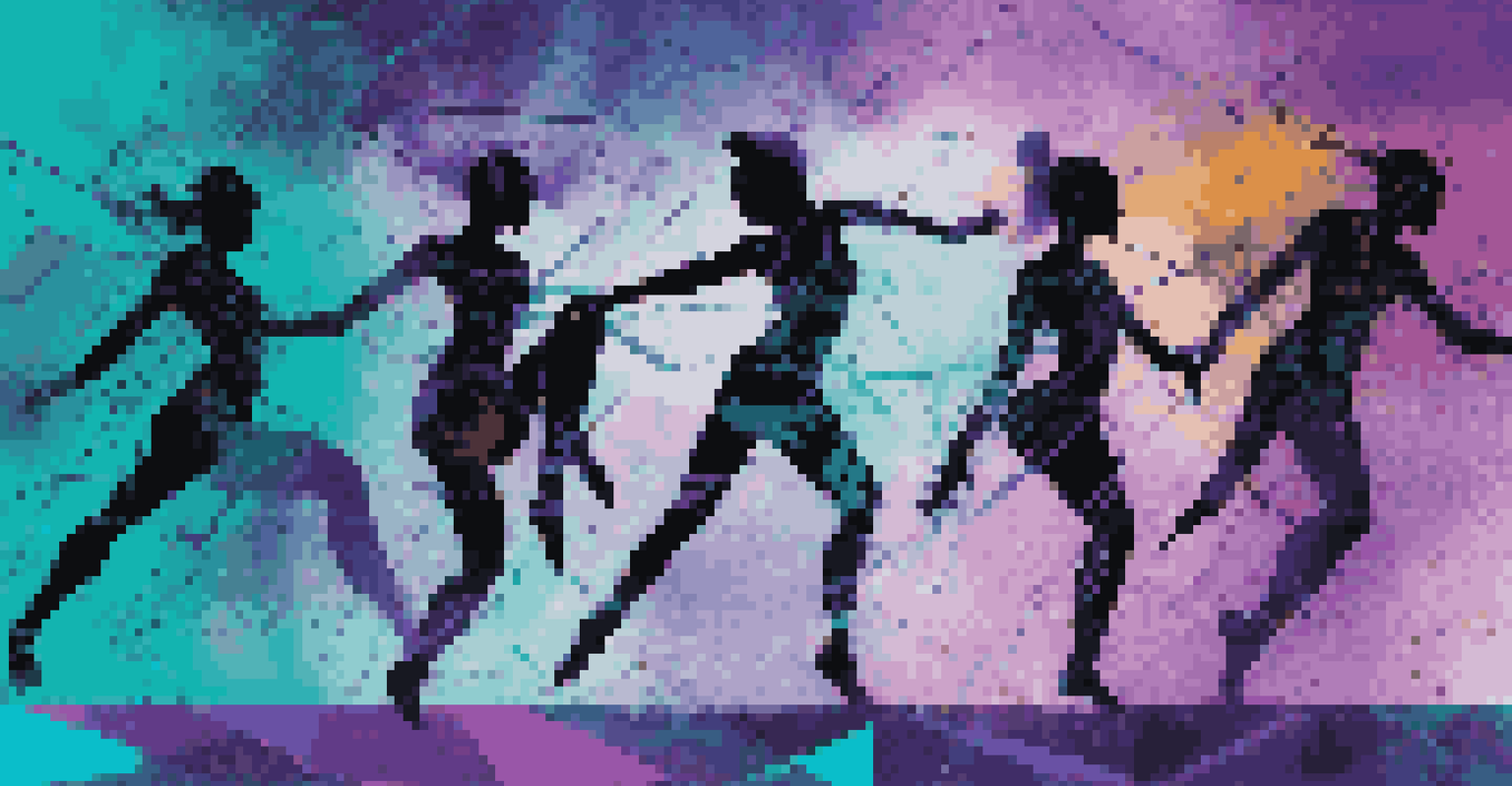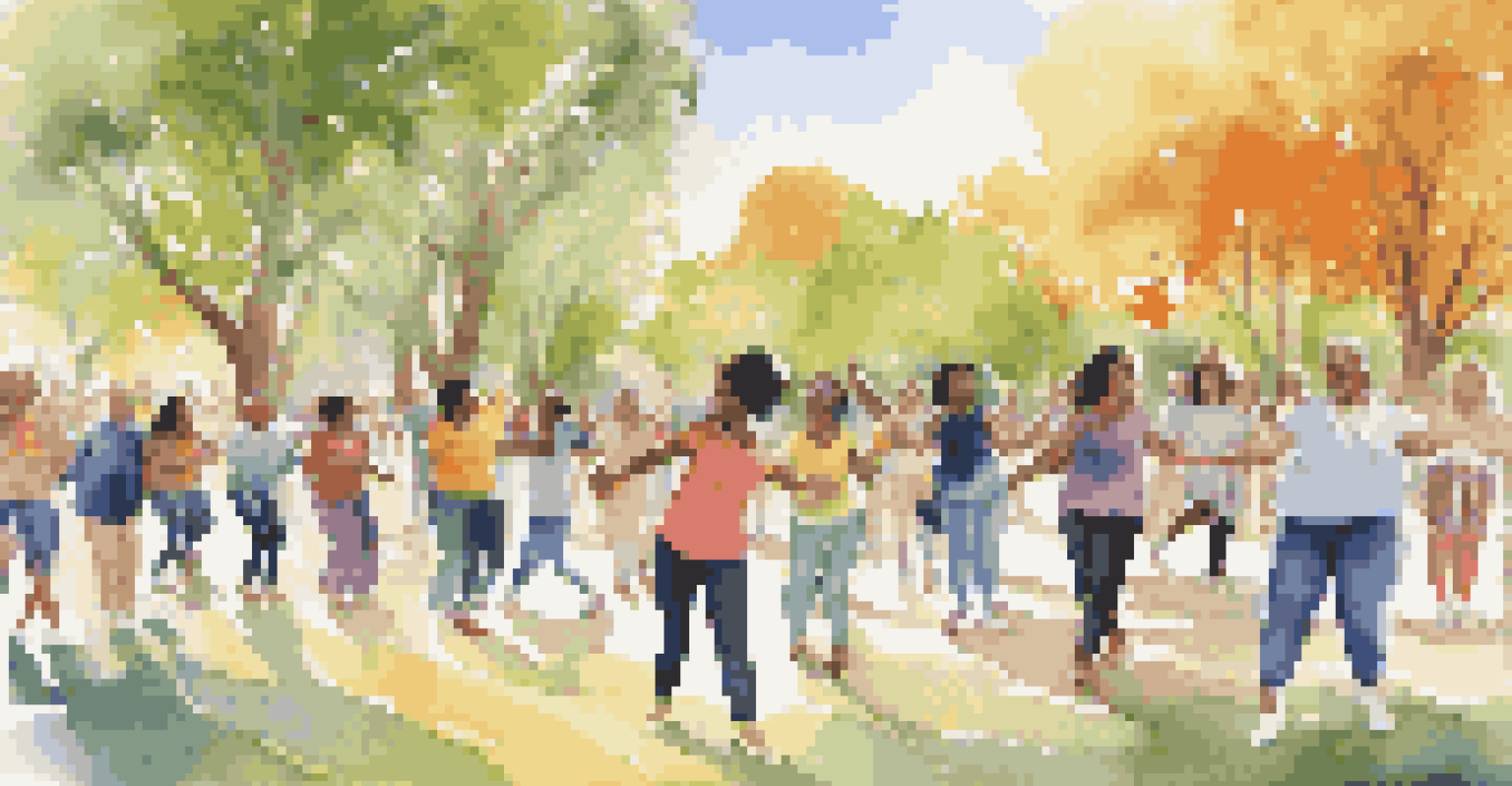The Role of Dance in Expressing Gender Identity Through Art

Understanding Gender Identity in Contemporary Culture
Gender identity is a deeply personal experience that encompasses how individuals perceive themselves and how they wish to be perceived by others. In today’s society, conversations around gender identity have become increasingly prominent, allowing for greater visibility of non-binary and transgender experiences. This evolving discourse influences various art forms, particularly dance, where movement becomes a powerful language for expressing one's identity.
Dance is the hidden language of the soul.
Within dance, individuals often find a safe space to explore and articulate their gender, challenging traditional norms that have historically defined masculine and feminine roles. Through choreography and performance, dancers can embody their authentic selves, using the physicality of dance to convey emotions and narratives tied to their gender experiences. The fluid nature of dance allows for a rich exploration of identity that transcends societal boundaries.
As artists push the envelope of what dance can represent, they invite audiences to reflect on their own perceptions of gender. This connection fosters empathy and understanding, highlighting the significance of supporting diverse expressions of gender identity within the arts. Ultimately, dance serves as both a personal exploration and a collective dialogue about gender in our contemporary world.
The Historical Context of Dance and Gender Expression
Dance has long been intertwined with gender roles, often reflecting the societal expectations of specific eras. Historically, ballet, for instance, has been seen as a feminine art form, while other styles, like hip-hop, have been dominated by male performers. This division not only reinforces stereotypes but also limits the spectrum of gender expression within these dance forms, making it crucial to revisit these narratives.

Throughout the decades, pioneering dancers and choreographers have challenged these conventions, using their art to highlight gender fluidity. For example, the avant-garde work of artists like Martha Graham and Alvin Ailey has opened doors for more inclusive representations within dance. Their innovative techniques and thematic explorations have inspired newer generations to break free from restrictive molds.
Dance as a Reflection of Identity
Choreography serves as a vital medium for expressing and reflecting diverse gender identities through movement and narrative.
As we analyze these historical shifts, it becomes clear that dance is not just an art form but also a reflection of evolving societal views on gender. This understanding provides a backdrop for contemporary dancers who continue to redefine gender identity through their performances, proving that dance can be a powerful medium for change and acceptance.
Dance as a Safe Space for Gender Exploration
For many, dance studios and performance spaces are sanctuaries where individuals can explore their gender identity without fear of judgment. This environment fosters creativity and allows dancers to experiment with movement, often leading to a deeper understanding of themselves. In these spaces, the act of dancing becomes a form of self-discovery, where individuals can embrace and express their true selves.
Art is not a mirror to hold up to society, but a hammer with which to shape it.
Various dance styles, from contemporary to street dance, offer unique ways to explore gender. For example, the fluidity of contemporary dance allows for a wide range of expression, enabling dancers to embody masculine, feminine, or non-binary characteristics freely. This versatility encourages individuals to challenge stereotypes, paving the way for broader acceptance of diverse identities.
Moreover, dance communities often provide support networks for those questioning their gender identity. Through collaboration and shared experiences, dancers forge connections that reinforce a sense of belonging. This sense of community not only uplifts individual journeys but also contributes to a collective movement advocating for inclusivity and representation within the arts.
Choreography: A Reflection of Gender Identity
Choreography serves as a powerful tool for expressing and reflecting gender identity. The decisions made in choreography—such as movement choices, formations, and interactions—can convey complex narratives about gender experiences. For example, a duet may highlight the dynamics of a same-sex relationship, showcasing how dance can communicate themes of love, struggle, and acceptance.
Many choreographers intentionally incorporate elements that challenge traditional gender norms, creating works that highlight the fluidity of identity. By playing with gendered movement styles, they draw attention to the limitations imposed by societal expectations. This intentionality in choreography can spark conversations about gender identity and the power dynamics that exist within various relationships.
Safe Spaces for Gender Exploration
Dance studios create supportive environments where individuals can freely explore and express their gender identity without judgment.
As audiences engage with these choreographic choices, they are invited to reflect on their own understandings of gender. This interaction not only broadens perspectives but also fosters a deeper appreciation for the artistry involved in conveying such nuanced themes through movement. In this way, choreography transcends mere performance, becoming a vital medium for social commentary and personal expression.
Performance Art and Gender Identity Narratives
Performance art often blurs the lines between various artistic disciplines, allowing for multifaceted expressions of gender identity. In this realm, dance can be interwoven with spoken word, visual art, and even multimedia elements to create a rich tapestry of storytelling. This hybrid approach enables artists to present their narratives in a holistic manner, engaging audiences on multiple sensory levels.
For instance, performers may use their bodies to challenge gender stereotypes while incorporating narrative elements that reflect their lived experiences. This can involve anything from costuming choices to the incorporation of historical references that speak to the complexities of gender identity. The result is a compelling performance that invites viewers to rethink their assumptions about gender.
Moreover, the ephemeral nature of performance art enhances its impact. Each performance is unique, creating a fleeting moment of connection between the artist and the audience. This immediacy can evoke strong emotional responses, prompting deeper conversations about gender identity and the societal structures that influence our understanding of it.
The Role of Technology in Dance and Gender Expression
In recent years, technology has revolutionized the way dance is created and shared, providing new avenues for exploring gender identity. Digital platforms allow dancers to showcase their work to global audiences, breaking down geographical barriers and fostering a diverse community. This accessibility encourages a wider range of voices to contribute to the conversation about gender in dance.
Virtual reality and interactive installations also offer fresh perspectives on movement and gender expression. By immersing audiences in digital environments, artists can create experiences that challenge traditional perceptions of gender. For example, a VR performance might allow viewers to experience the fluidity of gender through innovative movement and storytelling techniques.
The Impact of Technology on Dance
Advancements in technology provide new platforms for sharing dance, enabling broader conversations about gender identity across global audiences.
As technology continues to evolve, it will undoubtedly shape the future of dance and gender expression. This intersection opens up exciting possibilities for collaboration and experimentation, encouraging artists to push boundaries and redefine their narratives. Ultimately, technology empowers dancers to connect with audiences in new ways, amplifying their voices and stories.
Community Engagement and Advocacy Through Dance
Dance can serve as a powerful platform for community engagement and advocacy, particularly regarding gender identity. Various initiatives and organizations use dance as a means to raise awareness about gender issues, promote inclusivity, and foster acceptance. Through workshops, performances, and outreach programs, dancers can inspire change within their communities.
For example, some dance companies partner with LGBTQ+ organizations to create inclusive programming that addresses the challenges faced by marginalized groups. These collaborations not only provide visibility for underrepresented voices but also create safe spaces for dialogue and healing. In this context, dance becomes a medium for activism, using the arts to advocate for social justice.

Moreover, community-based dance projects often empower participants to share their own stories and experiences related to gender identity. This participatory approach emphasizes the importance of representation and allows individuals to connect through shared movement. By weaving together personal narratives, these projects foster a sense of belonging and community, reinforcing the idea that dance can be a transformative force in society.